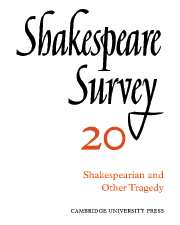Book contents
- Frontmatter
- Shakespeare, Fletcher and Baroque Tragedy
- Seneca and the Elizabethans: A Case-study in ‘Influence’
- George Chapman: Tragedy and the Providential View of History
- Critical Disagreement about Oedipus and Hamlet
- Shakespeare’s Thematic Modes of Speech: ‘Richard II’ to ‘Henry V’
- Anarchy and Order in ‘Richard III’ and ‘King John’
- The Staging of Parody and Parallels in ‘I Henry IV’
- Shakespeare’s Unnecessary Characters
- Walter Whiter’s Notes on Shakespeare
- Shakespeare’s ‘Romeo and Juliet’: Its Spanish Source
- The Grieves Shakespearian Scene Designs
- Shakespeare on the Modern Stage: Past Significance and Present Meaning
- Shakespeare in Brazil
- Recent Shakespeare Performances in Romania
- Shakespeare, the Twentieth Century and ‘Behaviourism’
- The Year's Contributions to Shakespearian Study 1 Critical Studies
- 2 Shakespeare’s Life, Times and Stage
- 3 Textual Studies
- Index
- Plate section
The Staging of Parody and Parallels in ‘I Henry IV’
Published online by Cambridge University Press: 28 March 2007
- Frontmatter
- Shakespeare, Fletcher and Baroque Tragedy
- Seneca and the Elizabethans: A Case-study in ‘Influence’
- George Chapman: Tragedy and the Providential View of History
- Critical Disagreement about Oedipus and Hamlet
- Shakespeare’s Thematic Modes of Speech: ‘Richard II’ to ‘Henry V’
- Anarchy and Order in ‘Richard III’ and ‘King John’
- The Staging of Parody and Parallels in ‘I Henry IV’
- Shakespeare’s Unnecessary Characters
- Walter Whiter’s Notes on Shakespeare
- Shakespeare’s ‘Romeo and Juliet’: Its Spanish Source
- The Grieves Shakespearian Scene Designs
- Shakespeare on the Modern Stage: Past Significance and Present Meaning
- Shakespeare in Brazil
- Recent Shakespeare Performances in Romania
- Shakespeare, the Twentieth Century and ‘Behaviourism’
- The Year's Contributions to Shakespearian Study 1 Critical Studies
- 2 Shakespeare’s Life, Times and Stage
- 3 Textual Studies
- Index
- Plate section
Summary
Considerable attention has been paid in recent years to the style of acting in Shakespeare’s day. Though evidence is meagre and the problem a controversial one, we can nevertheless be rather certain about the matter in general. We are told that by the late 1590s acting was neither ‘formal’ nor ‘natural’, or, to put it the other way, that it was both ‘formal’ and ‘natural’. It was ‘formal’ in that stylized and conventional gestures would express specific emotions: “ . . . an Elizabethan by means of gesture might validly communicate clearly and powerfully . . . what he was thinking, feeling, and willing to achieve when representing a character in an Elizabethan play”. ‘On cue, the actor could assemble detailed specific gestures into a visual emblem of an idea.’ We may find these gestures, derived from stage practices, in the handbooks on rhetoric. In regard to an awareness, too, of an overall thematic development, ‘the literary product of the writer’, Elizabethan acting was also ‘formal’, for imagery was projected by special emphasis.
On the other hand, Shakespearian acting was also 'natural'. The actor played his role as if he were that character. He read his lines with the emotional and intellectual responses inherent in them. He expressed the feelings and desires of the character with utmost faithfulness. The same imagery that may have revealed the author's vision might also have expressed the character's ideas and emotions. In short, imagery was for the Elizabethan actor both poetic and dramatic; and acting both 'formal' and 'natural'. In sum, Shakespeare's theatre 'possessed the capacity to accept mimetic action on two levels': the actor and character, the person representing (formal) and the person represented (natural).
- Type
- Chapter
- Information
- Shakespeare Survey , pp. 61 - 74Publisher: Cambridge University PressPrint publication year: 1967

